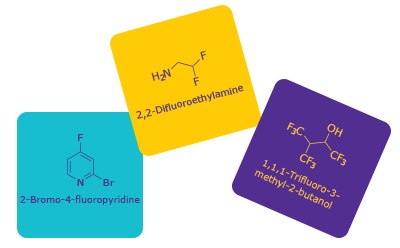Fluorinated Building Blocks

We’ll keep your work flowing with an extensive portfolio of fluorinated building blocks, including those with common and desirable substituents like trifluoromethyl (TFM), difluoromethyl (DFM), triflate, and pentafluorosulfanyl. The incorporation of a fluorine atom or a fluorinated alkyl group into organic molecules serves to modulate their physical and chemical properties, such as stability, reactivity, lipophilicity, and acidity with minimal steric perturbation, and can aid greatly in the identification of lead compounds.1 In addition, fluorinated building blocks show higher thermal stability when compared to their non-fluorinated counterparts. It is estimated that approximately 30% of all new approved drugs,2 more than 50% of approved blockbuster drugs,3 such as Lipitor® and Prozac®, and about 25% of licensed herbicides,1 such as Trifluralin and Flupoxam, incorporate one or more fluorine atoms and account for billions of dollars in annual sales.
In addition to having numerous applications in medicinal chemistry, fluorinated building blocks are also useful for material chemistry, agrochemistry, and general organic chemistry. For material chemistry, one of the most popular fluorinated compounds is polytetrafluoroethylene (PTFE), also known as Teflon, used for nonstick coating, lubricant, or the production of carbon fiber composites. The introduction of fluorine into herbicides and pesticides has led to a large sub-class of agrochemicals that shows improved performance over their non-fluorinated counterparts.
We also list a diverse array of perfluorinated and F-tagged building blocks, as well as fluorinated organometallic substrates. Add to that our breadth of common and unique fluorinating reagents, and you have a powerful toolkit to help you reach your new target compound frontiers.
Products
Related Resources
- Article: AlPhos and [(AlPhosPd)2•COD] for Pd-Catalyzed Fluorination
Fluorine containing aromatics (ArF) are desirable compounds with applications in medicinal chemistry and the agricultural industry.
References
To continue reading please sign in or create an account.
Don't Have An Account?